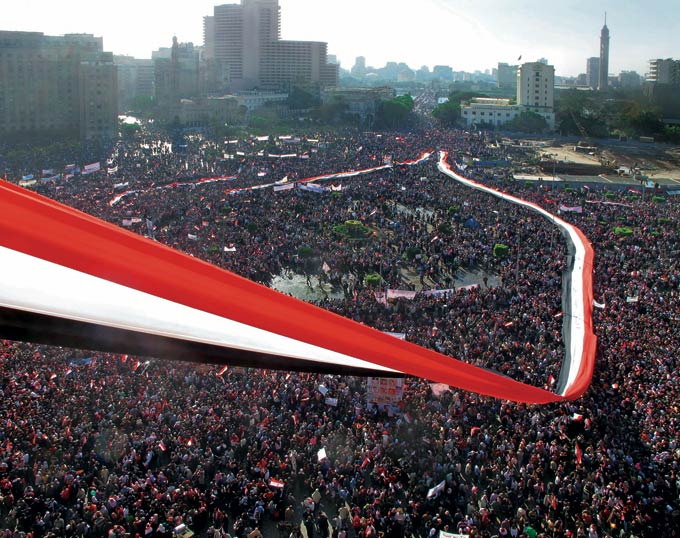
The “Friday of Victory” after Hosni Mubarak’s fall, Tahrir Square, Cairo, Egypt. Photo by Lara Baladi, February 18, 2011.
Photographs of Cairo’s Midan Tahrir (Tahrir Square) taken on the “Friday of Victory,” a week after a popular uprising forced President Hosni Mubarak to relinquish power, represent a better tomorrow—the birth of a new Egypt. These images portray Liberation Square as an oasis of peace and justice, a paradise regained, an icon of freedom and renewed Egyptian identity. Have these photos of Tahrir Square replaced those of the pyramids as the ultimate Egyptian cliché?
In August 1990, herds of Kuwaitis sought refuge in Egypt. These tourists-in-spite-of-themselves flocked to the Pyramids of Giza every day. My debut in photography coincided with this, Saddam Hussein’s first invasion of Kuwait. I, too, happened to be there on the Giza plateau, photographing the pyramids.
That winter, Operation Desert Storm became the first war to be broadcast live on television. The perversity of how this invasion was represented reaffirmed Guy Debord’s theory in The Society of the Spectacle: “All that once was directly lived has become mere representation.” The dark image in the convex screen was filled with occasional explosions in the night sky of an obscure city, CNN’s big fat logo ever-present in the lower left corner. As this “clean,” “bloodless” war was broadcast minute by minute to the world, the instantaneous mediation of unfolding events, America’s overwhelming military response and its new, elaborate surveillance technologies became subject to much criticism and analysis. Jean Baudrillard, in his controversial and often-cited text on that period, went as far as to suggest, “The Gulf War did not take place.” And indeed, many of the images that saturated our TV screens were perceived as surreal by many and inspired a whole new market of video games where soldiers, tinged by the green glow of infrared, crawl through the night.
Those who witnessed and photographed the attack on the World Trade Center in New York City contributed to breaking the long-established monopoly on the representation of reality. Citizen journalism was born.
A decade later, in 2001, the “casualty-free” representation of the Gulf War achieved in 1990 by CNN was turned on its head by a new generation of documentary photographers and filmmakers. The attacks of 9/11 in New York City was the first, major historical event to be documented by thousands of people with digital cameras, more thoroughly and effectively, as it happened, than by the mainstream media. They recorded the horror of people jumping out of windows, people covered in ashes running through the debris and carrying the wounded—trying to escape hell. But beyond recording, those who witnessed and photographed the attack on the World Trade Center in New York City contributed to breaking the long-established monopoly on the representation of reality. Citizen journalism was born.
In a little corner shop in London, the image of a plane exploding into the twin towers flashed on TV. While gathering my groceries, I asked the shopkeeper sitting under the screen what this was. She glanced at it fleetingly over her shoulder and said, with a shrug, “It must be a film.” Never in the history of cinema had a scene of this amplitude been shot. Action movies have been trying, and failing, to catch up ever since. Reality has surpassed fiction.
The Gulf War turned warfare, for many, into a computer game. In the Wikipedia entry for “Gulf War,” for example, a header reads: “‘Operation Desert Storm’ redirects here. For the video game, see Operation: Desert Storm (video game).” But ten years after the high-tech Gulf War, the photo and film amateurs documenting the collapse of the 110-story towers in Lower Manhattan re-humanized reality.
The first step toward the democratization of photography was George Eastman’s invention of the Kodak camera. In 1888, with the slogan “You press the button, we do the rest,” Eastman transformed a cumbersome and complicated procedure into something easy and obtainable. Photography, until then affordable only by an elite, became even more accessible after 1975, when another Eastman Kodak engineer, Steven Sasson, came up with another major invention: the digital camera. By 2001, a majority of people in the West had one. Snapping photos was no longer the hobby of amateurs but a fully integrated aspect of most people’s daily life.
Photographing was a political act, equal in
importance to
demonstrating.
In the following decade, as cameras made their way into mobile phones (smart or not), webcams were embedded in laptop and desktop screens and people uploaded millions of images to social media sites, the global democratization of photography took on a new dimension. With the emergence of social media, the traditional mass media lost even more ground on the distribution of information. Social media, in which the user participates in the process of selecting and distributing information, and make images instantaneously available worldwide, overshadowed traditional visual media. It competed with mainstream media, thus further sharing the power by shifting the hands holding it. “The power of letters and the power of pictures distribute themselves and evaporate into the social media such that it becomes possible for everyone to act instead of simply being represented,” observed the influential media artist, theorist and ZKM Center for Art and Media Karlsruhe director Peter Weibel in a recent article, “Power to the People: Images by the People.”
The shift was felt worldwide. When Israel attacked Lebanon in 2006, Lebanese online activists and bloggers attracted enough of the world’s attention to put international pressure on Israel and help stop the war. Short-lived but devastatingly destructive, this war lasted long enough to spark the beginning of a new trend of online political activism in the whole Arab region.
“The Revolution Will Be Flickrised”
On January 25, 2011, I was at home in Cairo with a few friends. None of us knew, beyond the unusual, eerie silence in the street, how unprecedented the protests were. To distract ourselves from the growing tension outside, we played a game of memory, illustrated with black-and-white photographs from the archive of the Arab Image Foundation (AIF). As I played with these past images from the Arab world, little did I know that the history of the region, of Arab photography and of photography in general was about to take a quantum leap.
Photographing in Egypt was prohibited in many areas during the Mubarak era; I was arrested no fewer than seven times over fifteen years for taking pictures in various parts of the country. Fear-mongering propaganda made people paranoid, feeding an ever-present and general suspicion of the camera, and by extension, of the “other.” Complicit as societies become under dictatorship, Egyptians had for generations bowed to routine police humiliation in broad daylight, and worse brutality in the darkness of their torture chambers. Very few images of these crimes had gone public. The 2008 Mahalla protests by textile mill workers revived the notion that we had a right to see and be seen. Egyptian activist Hossam el-Hamalawy, blogged then, “The revolution will be flickrised,” pointing to the need to document and disseminate the regime’s repressive procedures. Seeing would mean believing and revolting for those blinded by the national media, which persistently concealed the reality of the power in place for 30 years.
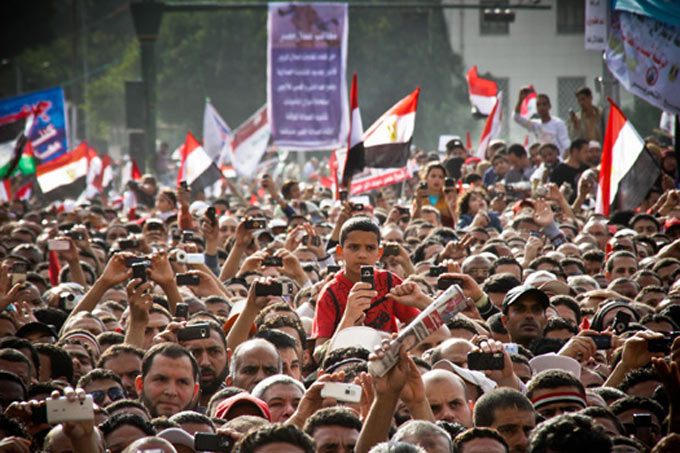
Protesters during a speech in Tahrir Square, April 8, 2011. Photo by Mosa’ab Elshamy. © Mosa’ab Elshamy.
This was never truer than in Tahrir Square during the 18 days of the 2011 revolution. Here, and in the whole region during the Arab uprisings, the act of photographing became not only an act of seeing and recording; it was also fully participatory. At the core of the Egyptian uprising, photographing was a political act, equal in importance to demonstrating. It constituted civil disobedience and defiance of the regime.
In the midst of the emergency, all theories on the subjectivity of photography suddenly became irrelevant. During the 18 days, people in the square took photos because they felt the social responsibility to do so. Photography became objective; photography showed the truth—yes, a Truth made of as many truths as there were protesters in the square, but nonetheless one that urgently had to be revealed at this turning point in history. The camera became a nonviolent weapon aimed directly at the state, denouncing it. Photographing implied taking a stand against the regime; it was a way of reconquering territory and ultimately the country. Photographing meant belonging.
In his classic BBC series, Ways of Seeing, John Berger tells us, “The images come to you. You do not go to them. The days of pilgrimage are over.” Commenting on our experience of images in the digital age, Slovenian philosopher and cultural critic Slavoj Žižek argued that “what goes on today is not ‘virtual reality’ but the ‘reality of the virtual.’” A media revolution also took place in Tahrir, when the reality of the streets reached the reality on our screens. The images coming to us through our screens, finally, were “reality.”
Protesters held above their heads signs and slogans by day, and the blue glowing lights of mobile phones, iPads and even laptops, by night.
Around the world—except in China, where the government banned the word “Egypt” from its Google search engine—images of Tahrir spilled into living spaces. Transcending computers, televisions screens and other virtual channels, the images inexorably spread the energy of the square. As Žižek said when interviewed about the Arab revolutions, “It was a genuine universal event, immediately understandable… As every true universality, it’s a universality of struggle.” Unlike during other conflicts that provoked a media shift, namely the Gulf War and 9/11, people all over the world identified with the protesters in the square. Tahrir became everyone’s revolution. Occupy movements followed in a chain reaction. There was a wave of awakening from Tunisia to Egypt, Libya and other Arab countries, and from Cairo to Madrid, Athens and beyond. The cause differed but the inspiration was contagious. Was image-making impacting the world and, if not changing it, shaking its order by helping people to rethink their relationship to political powers?
Thousands of people moved, photographed and stood together in solidarity against totalitarianism. Protesters held above their heads signs and slogans by day, and the blue glowing lights of mobile phones, iPads and even laptops, by night. While signifying the demand for social justice and freedom, these devices were not only emanating a light of hope reminiscent of the dancing flames during the protests of the sixties; they were simultaneously absorbing the ambient light, thus recording from every possible angle, in every possible quality and format, life in Tahrir.
The mainstream international media grabbed the event and sucked everything it could out of it. While it supported the crowds in Tahrir, it also diminished the revolution’s momentum by referring to it in the past tense after the 18 days and moving on to other news, thus confirming Marshall McLuhan’s theory that “you can actually dissipate a situation by giving it maximum coverage.” At this point, ordinary people had embraced the power of online images to such an extent that television news, often way behind the news on the ground, started broadcasting videos shot by amateurs or activists that had already gone viral on the web. Never, since the invention of the camera, had a historical event been so widely documented, with more videos and photos than there were protesters in the square.
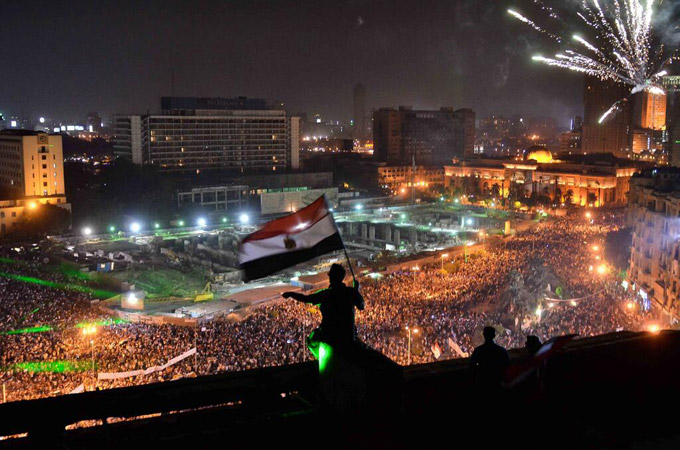
Cairo’s Tahrir Square seen after the ouster of Mohammed Morsi. Photo by Mohamed El Shahed, July 8, 2013.
Desensitization to Reality
The new economy brought about by digital photography has exponentially amplified photography’s intrinsic factory-like quality, which is both its greatest promise and its greatest threat. On the one hand, anyone who owns a camera can produce limitless images for free. On the other hand, the abundance of rapidly distributed images is accompanied by a lack of critical distance; for example, images altered in Photoshop are mostly taken at face value. This contributes to a general desensitization to reality. Vilém Flusser, in his 1984 book Towards a Philosophy of Photography, rightly warns us of the dangers of this hyper-democratization of photography in the digital age: “Anyone who takes snaps has to adhere to the instructions for use—becoming simpler and simpler—that are programmed to control the output end of the camera. This is democracy in the post-industrial society. Therefore people taking snaps are unable to decode photographs: they think photographs are an automatic reflection of the world.”
The most enduring Orientalist Egyptian cliché of them all, the Giza Pyramids, has been upstaged by the bird’s eye picture of a million people in Tahrir.
During the Arab uprisings, a great number of shaky and blurry mobile phone videos shot in Syria, Libya and Bahrain, uploaded every day onto the internet, were not “decodable.” Many battle scenes, highly pixelated and graphic, resembled each other, yet, nothing in them was clearly definable or, in itself, recognizable. Only the titles revealed the videos’ content. Viewers easily disengaged from following or attempting to understand how these uprisings were evolving, or if they did try, once again they referred to and relied on the mainstream media, thus surrendering power all over again.
How long will the most extensive, multi-vocal documentary ever made—the extraordinary and unedited portrait of Egyptians in Midan Tahrir one finds online— survive in the ephemeral virtual archive? With most of the images of the 18 days vanishing into a bottomless pit thanks to Google’s PageRank algorithm, will the vision of a possible new world people glimpsed in the Square die along with its digital traces?
Although the endless proliferation of images in Tahrir was produced for our own national consumption rather than that of a Western audience, images from the square almost instantly turned old established clichés of Egypt on their heads. The angry Arab terrorist became a dignified peace warrior. “Egypt! Help us. One World, One pain,” read banners in the protests that erupted in Wisconsin, in the US three weeks after the Egyptian uprising. The once “dirty Arab” had transformed into a politically and socially conscious citizen. U.S. President Barack Obama even declared in a television speech he gave after the Battle of the Camel in the midst of the 18 days: “We should raise our children to be like Egyptian youth.”
In French, the word cliché means “photograph”; for the rest of the world it only refers to a stereotype that, while familiar, conceals more truths than it reveals. The most enduring Orientalist Egyptian cliché of them all, the Giza Pyramids, has been upstaged by the bird’s eye picture of a million people in Tahrir. People circulating around the tents in the center of the square resonated, at times, with images of people praying around the Kaaba in Mecca. For about a year after the revolution started, Tahrir itself was a pilgrimage site for revolution tourists.
One of the oldest debates in photography is its relationship with death: “Photographs are a way of imprisoning reality,” writes Susan Sontag in On Photography. “One can’t possess reality. One can possess (and be possessed by) images—as…one can’t possess the present but one can possess the past.” The fear of death and the fear that the vision born in Tahrir would vanish soon after President Hosni Mubarak stepped down may have been what pushed people to take images incessantly while there. Ultimately, photographing in Tahrir was an act of faith. As if recording the ecstatic reality of the present would remind us, in the future, of the Square’s utopian promise, and help us to keep hope when the real battle would start.
Back to Tahrir
After January 25, 2011, Tahrir surely replaced the pyramids as the ultimate cliché—a new synecdoche for Egypt. The square continues to be the center of protests, a synonym for political power and the barometer for the revolution’s failure or success. Images of the square have become part of our daily visual consumption routine. At times Tahrir appears to be a parody of itself; at times the center of renewed hope.

Cairo’s Tahrir Square seen immediately after the ouster of Mohammed Morsi, on July 3, 2013. Photo courtesy of Lara Baladi. Photographer unknown.
Whether the revolutionaries, the Muslim Brotherhood or the Salafis took Tahrir Square, owning the square meant owning the revolution and by extension, Egypt. As the battle for the square worsened, Tahrir came to represent a divided nation. Rifts among Egyptians intensified during and after the first presidential campaign that followed Mubarak’s toppling, in which Mohamed Morsi won under dubious circumstances. In the midst of an economic free fall, he issued a constitutional decree granting himself virtually unchecked power. Egyptians took to the streets again, having lost all trust in his promises to support the revolution and Egypt’s interests at large. Only six months within his mandate, President Mohammed Morsi had managed to irreversibly part Egypt in two.
In May 2013, a group of young Egyptians launched a national petition calling for early presidential elections. The movement, Tamarod, known in English as the “rebel” campaign (but meaning “mutiny” in Arabic), invited Egyptians to occupy Tahrir and the premises outside the presidential palace on June 30, the day when the petition would be submitted to the Egyptian Supreme Court.
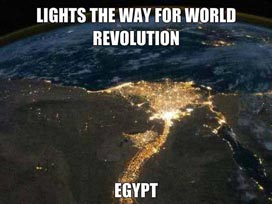 Tamarod collected 22 million signatures, an enormous number in a country with an electorate of 51 million that is comparable to the 26 million who voted in the second round of the presidential campaign. On June 30, Tahrir Square filled up more than it did on January 25, 2011—more than it ever had, before or since. As all the squares in Cairo were occupied with protesters demanding the removal of President Morsi, a NASA photograph of Egypt from the sky—showing the Nile illuminated, with a Photoshopped caption, “Egypt lights the way for the world revolution”—circulated on social media. The photo perfectly illustrated the experience for the overwhelming majority of Egyptians who, if only for a moment, united in a common goal and spirit. The intensity of the euphoria experienced on the ground burst every TV screen.
Tamarod collected 22 million signatures, an enormous number in a country with an electorate of 51 million that is comparable to the 26 million who voted in the second round of the presidential campaign. On June 30, Tahrir Square filled up more than it did on January 25, 2011—more than it ever had, before or since. As all the squares in Cairo were occupied with protesters demanding the removal of President Morsi, a NASA photograph of Egypt from the sky—showing the Nile illuminated, with a Photoshopped caption, “Egypt lights the way for the world revolution”—circulated on social media. The photo perfectly illustrated the experience for the overwhelming majority of Egyptians who, if only for a moment, united in a common goal and spirit. The intensity of the euphoria experienced on the ground burst every TV screen.
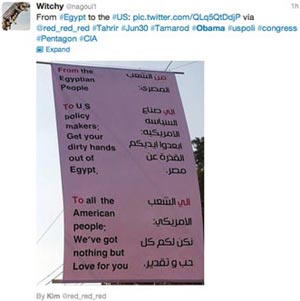 The unbelievable but true turn of events in Egypt disturbed the West’s political agendas—particularly the aims of the United States. While Obama was supporting the supposedly democratic process that elected President Morsi, his administration refused to name the event a “coup” or “not a coup” in order to legally continue to give $1.5 billion in aid to Egypt’s army, meanwhile supporting whatever party would uphold the political status quo. As a result, Tahrir’s banners were dominated by anti-Obama slogans.
The unbelievable but true turn of events in Egypt disturbed the West’s political agendas—particularly the aims of the United States. While Obama was supporting the supposedly democratic process that elected President Morsi, his administration refused to name the event a “coup” or “not a coup” in order to legally continue to give $1.5 billion in aid to Egypt’s army, meanwhile supporting whatever party would uphold the political status quo. As a result, Tahrir’s banners were dominated by anti-Obama slogans.
Egypt was now defying the very core of the democratic process. Messages like the following one circulated on people’s Facebook walls:
Know that almost every democracy in the world has now been dragged into this public debate about what is democratic legitimacy… Yes, Egyptians have questioned [the] ballot box legitimacy, and YES, we asked our army to intervene when we found our political opponents bringing out their militias.
Since the uprising on June 30, the removal of President Morsi on July 3 and the massacre of his supporters outside the Republican Guards Club on July 8, the role of the army has yet again been heavily questioned. However, in the early days, many Egyptians used social media to voice their anger that Western media portrayed the events as a “coup” rather than a military intervention in support of and responding to mass mobilization against President Mohammed Morsi and the Muslim Brotherhood.
Although the means of making and distributing images have not drastically changed since January 25, 2011, the events of June 30 initiated an important shift in the history of image making. The unprecedented scission between social media and the mainstream media that took place around Tahrir at that time marks the beginning of an era in which the role played by the latter can only become obsolete and vanish if it continues to cover news with obvious biases. It does not matter how long this will take; the process has been irreversibly set in motion.
In the days immediately following this new turn of events in Egyptian politics, 22 Al Jazeera journalists resigned, accusing the Qatar-based network of airing lies and misleading viewers. Reporting for Al Arabiya, Nada Altuwaijri characterized these resignations as “criticism over the channel’s editorial line, the way it covered events in Egypt, and allegations that journalists were instructed to favor the Brotherhood.” Meanwhile, CNN’s broadcasts reminded us of its biased coverage of the Gulf War; the network’s coverage reflected its own spectacular narrative rather than the reality on the ground. CNN not only naively confused images of pro-Morsi demonstrations with anti-Morsi demonstrations, but were also bluntly oblivious to the voices of the majority of the Egyptian people expressing their will. CNN’s crew was thrown out of Tahrir Square, along with many other foreign journalists, because protesters refused to be misrepresented—from the start, this revolution has been about self-determination in media as in society.

A laser projects the text “It is not a coup” onto the facade of the Mogamma, a government building in Cairo’s Tahrir Square, after Mohammed Morsi’s ouster in early July 2013. Photographer unknown. Courtesy of Lara Baladi.
In the meantime, the Egyptian army, responding to people’s demands, reclaimed control over the national media and gave President Morsi an ultimatum to resign. He refused. The army arrested him and is still detaining him.
On June 30, the power of the image was handed back to the people, for the people. Someone even tweeted that a meteorite should fall on Tahrir. Did this message imply that Tahrir should now officially be the sacred pilgrimage site for a redefined Egypt? Or more, that it should become the Mecca of a rebirthing Arab world, one in the process of seeking a new political practice and redefining democracy in ways the West has yet to imagine?
When Napoleon Bonaparte addressed his army before the Battle of the Pyramids, he said, “Soldiers! Forty centuries behold you!” Tahrir, by dethroning the pyramids, brought Egypt back to the present.
This piece was originally published in the catalogue for the exhibition “Cairo, Open City: New Testimonies from an Ongoing Revolution,” Museum Folkwang in Essen, Germany, and has been updated for Creative Time Reports following the events that took place in Egypt during the summer of 2013.

